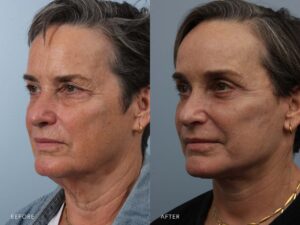The first step in performing a facelift is making an incision through the skin of the face and neck. Although there are slight variations in incision types depending on your surgeon, the facelift incision is carefully designed to hide or minimize scars.
Facelift Incisions: Explained
The incision starts in an area of the face just to the side of your eyebrow called the temporal area.
Here, the incision is made within the temporal hairline so that over time, hair will grow through the scar and conceal it.
The temporal incision follows hair-bearing skin and curves down towards the upper part of the ear. The incision then follows a naturally occurring skin crease just in front of the ear. This region of the face is called the preauricular area.
The preauricular incision is individualized and may be different between a male and female patient. In the front edge of the ear, there is a cartilage bump called the tragus. In a male patient, the incision is usually made in front of the tragus whereas in a female patient, the incision is made behind the tragus. The reason for these differences has to do with the presence or absence of a skin crease and the distribution of facial hair in men. The preauricular incision curves down around the ear lobe and into the sulcus behind the ear. This part of the incision behind the ear is not visible in the front view as it is hidden by the ear itself. The facelift incision does not change the position or shape of the ear. It simply “wraps around” the ear and follows skin wrinkle lines.
Behind the ear, the facelift incision is made within the hairline again. Here, the incision extends towards the back of the neck. This portion of the incision allows your surgeon to lift and pull the deep tissues within the neck, giving a sharper jawline and removing the sagging in the front of the neck. Similar to the temporal incision, your surgeon will attempt to hide the scar within the hairline in the back of the neck so it becomes less noticeable.
The incision for a facelift is designed to make your scar as hidden as possible.
Your surgeon will also place deep sutures along the incision to relieve tension on the skin, which will help with decreasing the chance of thickened scarring.
When will scarring and swelling decrease?
At the beginning, the incision will be held together by a lot of sutures. Some surgeons also place staples in the neck incision.
After about a week, the sutures (or staples, if used) will be removed in the office. At that point, the scar will be visible, red, and slightly raised from normal post-surgery swelling.
At about two to three weeks after surgery, the amount of swelling should decrease significantly, although the scar will still appear red.
In the first few weeks after surgery, different types of collagen will fill in the incision and the scar will begin to mature and contract.
Contraction of scar tissues will continue for 6 to 18 months after surgery. During this time, the initially red scar will begin to turn into a lighter pink, and the swelling on the edges of the scar will fade as well.
As time goes on, the facelift scar will continue to lighten and eventually, the scar will appear pale and be barely noticeable. Although the incision is made within the hairline in multiple places, many patients will be able to wear their hair up without worrying about a visible scar.
Over time, hair will grow into the scar in the temporal and neck regions, which will further conceal the scars. In a nutshell, the facelift incision does leave a faint scar on the side of the face and back of the neck. For most patients, the scar will become very faint and not noticeable by others around them.
How to care for incisions to prevent thickened scarring
Your surgeon will give you detailed instructions on how to care for wounds throughout the healing process. Various ointments or cream are applied to the incision to promote healing, including an antibiotic ointment in the first few days after surgery, followed by a water-based ointment such as Vaseline or Aquaphor for several weeks after surgery.
Some experts also suggest the use of silicone, such as the Biocorneum® skincare products. Silicone-containing cream or paste can be applied directly onto the incision several weeks after surgery and are meant to prevent thickened scarring.
Always speak with your surgeon about the exact type of wound care and skincare regimen you should follow after a facelift.

